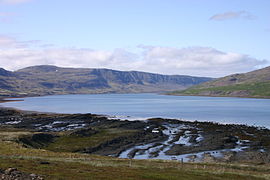Vestfirðir
Population
The lack of flat lowlands in the area limits the potential for agriculture, which is mostly restricted to low-intensity sheep grazing near the fjords. Good natural harbors in many of the fjords and their proximity to fishing areas are vital for the local economy. The Westfjords are very sparsely populated, even by Icelandic standards; the total population in 2024 was 7,168. The largest settlement is Ísafjörður, with a population of 2,679.
| year | population | % of Iceland's population |
| 1920 | 13,443 | 14.24% |
| 1930 | 13,133 | 12.09% |
| 1940 | 13,130 | 10.80% |
| 1950 | 11,300 | 7.83% |
| 1960 | 10,507 | 5.86% |
| 1970 | 10,050 | 4.91% |
| 1980 | 10,479 | 4.53% |
| 1990 | 9,798 | 3.80% |
| 2000 | 8,150 | 2.86% |
| 2007 | 7,309 | 2.32% |
| 2020 | 7,115 | 1.95% |
Main settlements in the Westfjords
- Reykhólar
- Bolungarvík
- Brjánslækur [ˈprjaunsˌlaiːkʏr̥]
- Ísafjörður
- Tálknafjörður
- Flateyri
- Suðureyri
- Hnífsdalur
- Súðavík
- Bíldudalur
- Þingeyri
- Patreksfjörður
- Skálanes
- Hólmavík
- Drangsnes
Climate
The box is for Göltur [ˈkɔl̥tʏr̥], at the tip of the peninsula 20 km (12 mi) northwest of Ísafjörður. Westfjords is generally the coldest area at sea level in Iceland, as a result of the East Greenland Current.
| Climate data for Göltur | |||||||||||||
|---|---|---|---|---|---|---|---|---|---|---|---|---|---|
| Month | Jan | Feb | Mar | Apr | May | Jun | Jul | Aug | Sep | Oct | Nov | Dec | Year |
| Record high °C (°F) | 10 (50) |
10 (50) |
11 (52) |
11 (52) |
17 (63) |
18 (64) |
19 (66) |
18 (64) |
15 (59) |
15 (59) |
13 (55) |
11 (52) |
19 (66) |
| Mean daily maximum °C (°F) | 1 (33) |
2 (35) |
3 (37) |
4 (40) |
7 (44) |
9 (49) |
11 (51) |
11 (51) |
7 (45) |
5 (41) |
4 (40) |
2 (35) |
6 (42) |
| Daily mean °C (°F) | −2 (29) |
0 (32) |
1 (33) |
2 (36) |
4 (40) |
7 (45) |
8 (47) |
8 (47) |
6 (42) |
3 (38) |
3 (37) |
0 (32) |
3 (38) |
| Mean daily minimum °C (°F) | −3 (26) |
−2 (29) |
−1 (30) |
1 (33) |
2 (36) |
5 (41) |
7 (44) |
7 (44) |
4 (40) |
2 (35) |
1 (34) |
−1 (30) |
2 (35) |
| Record low °C (°F) | −11 (12) |
−10 (14) |
−13 (9) |
−7 (19) |
−4 (25) |
−2 (28) |
2 (36) |
1 (34) |
−3 (27) |
−5 (23) |
−9 (16) |
−9 (16) |
−13 (9) |
| Average relative humidity (%) | 75 | 77 | 76 | 79 | 77 | 82 | 83 | 81 | 82 | 79 | 80 | 78 | 79 |
| Mean daily sunshine hours | 6 | 9.2 | 12.7 | 16.6 | 20.7 | 23.4 | 21.5 | 18.1 | 13.9 | 10.3 | 6.9 | 4.6 | 13.7 |
| Source: Weatherbase | |||||||||||||
Law
In 1615, 32 shipwrecked Basque whalers were killed by locals, after which the magistrate made it law that any Basque person seen in the region should be instantly killed. This law was repealed in May 2015.
Wildlife
The Westfjords are famous for their large Arctic Fox population. The density of Arctic Fox in some parts of Hornstrandir nature reserve (such as Hornvik) is the highest in the world.
In addition, Látrabjarg cliffs in the south-west of the peninsula are the most important seabird nesting site in Iceland, and one of the most important in Europe. The most common birds in the Westfjords are the Arctic tern, northern fulmar, black-legged kittiwake, Atlantic puffin, common guillemot, black guillemot, red-necked phalarope and ducks such as the common eider and harlequin duck.
Image gallery
-
Westfjords
-
Dýrafjörður
-
Puffins in Látrabjarg
-
Oldest steel ship in Iceland
-
Látrabjarg
-
Hrafnseyrarheiði
-
Hvítanes
-
Suðureyri
-
Landscape near Þingeyri
See also
- Barðaströnd
- Bjarkalundur
- Westfjords Heritage Museum
- Regions of Iceland
- Tunnels in Iceland
- Basque–Icelandic pidgin
References
- ^ "Inhabitants – Municipalities and urban nuclei". statice.is. Statistics Iceland. 1 January 2024. Retrieved 19 December 2024.
- ^ Westfjords, Visit. "The Westfjords now EarthCheck Certified". Visit Westfjords. Retrieved 2023-12-04.
- ^ "Weatherbase: WEATHER AVERAGES SUMMARY for Goltur, Iceland". Weatherbase. 2013. Retrieved on June 1, 2013.
- ^ Tharoor, Ishaan (28 May 2015). "Iceland revokes 400-year-old legal right in Westfjords district to kill Basques on sight". The Independent. Retrieved 2 June 2015.









